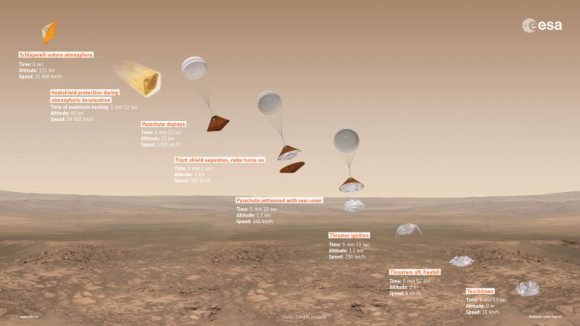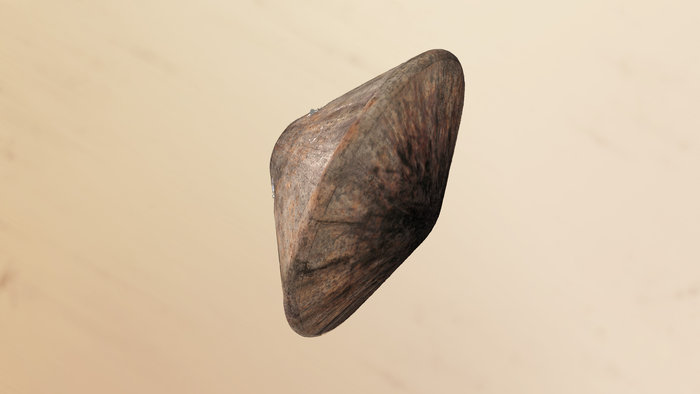The European Space Agency (ESA) and Roscomos (the Russian federal space agency) had high hopes for the Schiaparelli lander, which crashed on the surface of Mars on October 19th. As part of the ExoMars program, its purpose was to test the technologies that will be used to deploy a rover to the Red Planet in 2020.
However, investigators are making progress towards determining what went wrong during the lander’s descent. Based on their most recent findings, they concluded that an anomaly took place with an on-board instrument that led to the lander detaching from its parachute and backshell prematurely. This ultimately caused it to land hard and be destroyed.
According to investigators, the data retrieved from the lander indicates that for the most part, Schiaparelli was functioning normally before it crashed. This included the parachute deploying once it had reached an altitude of 12 km and achieved a speed of 1730 km/h. When it reached an altitude of 7.8 km, the lander’s heatshield was released, and it radar altimeter provided accurate data to the lander’s on-board guidance, navigation and control system.

All of this happened according to plan and did not contribute to the fatal crash. However, an anomaly then took place with the Inertial Measurement Unit (IMU), which is there to measure the rotation rates of the vehicle. Apparently, the IMU experienced saturation shortly after the parachute was deployed, causing it to persist for one second longer than required.
This error was then fed to the navigation system, which caused it to generate an estimate altitude that was below Mars’ actual ground level. In essence, the lander thought it was closer to the ground than it actually was. As such, the the parachute and backshell of the Entry and Descent Module (EDM) were jettisoned and the braking thrusters fired prematurely – at an altitude of 3.7 km instead of 1.2 km, as planned.
This briefest of errors caused the lander to free-fall for one second longer than it was supposed to, causing it to land hard and be destroyed. The investigators have confirmed this assessment using multiple computer simulations, all of which indicate that the IMU error was responsible. However, this is still a tentative conclusion that awaits final confirmation from the agency.

As David Parker, the ESA’s Director of Human Spaceflight and Robotic Exploration, said on on Wednesday, Nov. 23rd in a ESA press release:
“This is still a very preliminary conclusion of our technical investigations. The full picture will be provided in early 2017 by the future report of an external independent inquiry board, which is now being set up, as requested by ESA’s Director General, under the chairmanship of ESA’s Inspector General. But we will have learned much from Schiaparelli that will directly contribute to the second ExoMars mission being developed with our international partners for launch in 2020.”
In other words, this accident has not deterred the ESA and Roscosmos from pursuing the next stage in the ExoMars program – which is the deployment of the ExoMars rover in 2020. When it reaches Mars in 2021, the rover will be capable of navigating autonomously across the surface, using a on-board laboratory suite to search for signs of biological life, both past and present.
In the meantime, data retrieved from Schiaparelli’s other instruments is still being analyzed, as well as information from orbiters that observed the lander’s descent. It is hoped that this will shed further light on the accident, as well as salvage something from the mission. The Trace Gas Orbiter is also starting its first series of observations since it made its arrival in orbit on Oct. 19th, and will reach its operational orbit towards the end of 2017.
Further Reading: ESA


The explanation of the anomaly does not make coherent sense. What does the rotation rate of the craft have to do with altitude? Why would a failure with that instrument then translate into an incorrect estimate of the altitude of the craft which is what really doomed the landing? Every pilot knows that an incorrect reading of the altimeter can result in a fatal crash, in fact there was one in the Netherlands in 2009.
the MER-B Opportunity rover is approach its 13th Martian anniversary next January 25th. It is doing a great job exploring the western rim of Endeavour crater, a couple dozen kilometers to the East of Schiaparelli lander’s ultimate resting place.
First it has to get ready for the local winter, but in 6 or 7 months, it might be a possibility that once back out of Endeavour, it could get across the flat plain in 125-150 sols to get a real close-up look at the debris and provide more data to learn from.
Oppy’s R.A.T. (Rock Abrasion Tool) must be starting to wear down by now and our old friend could become the 1st to rendez-vous with another piece of hardware sent from Earth before it’s threatened with having its plug pulled at the next budget…
Surely you want to see the Noachian gully that is Oppy’s next destination? 🙂 Oppy has studied debris from Earth previously (its own heatshield) and from that encounter, they resolved never to do that again (debris contaminated Oppy’s hazcams). The funding is secure due to the exciting new science expected from the gully; driving in the opposite direction to see some Earthly debris would definitely not be funded…
Shouldn’t the title be, “Schiaparelli’s One Second Of Error”?
Not quite, thought that would be accurate too. The “terror” refers to the extra second of free fall it experienced that sealed its fate.
After I made the above post, I ‘cruised’ to other astronomy sites and saw 2 more instances where authors also alluded to ‘one second of error’! That’s all it took for Schiaparilli fate to be determined… actually less. Still, now you know me as a punster? E caveat emptor! ~@; )
AQUA4U, yes an accurate title would be, “Schiaparelli’s One Second Of Error.”
Most respectfully, Mr. Matt Williams, the title, “Schiaparelli’s One Second Of Terror,” is not “accurate too.” While, as you explained, “The ‘terror’ refers to the extra second of free fall it experienced that sealed its fate;” to refer to the “extra second of free fall,” which, supposedly, was the cause of the craft’s failure, using the word, “terror,” is nonsensical.
“Terror,” is a state of fearfulness, and the term carries the implication of being a state of fearfullnes to an ‘intense,’ ‘mortal,’ ‘deep,’ and/or ‘grave,’ degree. A state of fearfulness is the result of neural & hormonal* responses triggered by perceived external stimuli- and is a state uniquely experienced by living organisms.
The Schiaparelli lander is (or “was,” per reader’s choice) an unmanned spacecraft- in other words, a piece of machinery, devoid of living organisms (…probably, & as far as what is known). Beyond all reasonable doubt, the lander did not itself experience any “terror”- not even during, “the extra second of free fall it experienced that sealed its fate,” (or, ‘the one-second of premature, gravitational acceleration of the lander towards Mars, hypothesized to have resulted in the mission failure’).
The Schiaparelli lander, with the exception of a few built-in, on-board devices engineered to collect & store data relevant to the lander’s performance (or failure to function), was ‘destroyed’- not ‘killed.’ Your chosen phrase of reference to the lander’s destruction, “the fatal crash,” is an incorrect characterization of the event: nothing about the Schiaparelli’s crash landing was, “fatal.” In the event of malfunction & consequential destruction of a spacecraft, the term for the event is, “mission failure which claimed craft.”
The multiple instances of Mr. Matt Williams anthropomorphization of the Schiaparelli lander in this article use heavily loaded terms: “the fatal crash” (Who died? Nobody); “the lander thought…” (If the lander, “thought,” that would be the real story!), “the accident,” (there are no ‘accidents’ in astrophysics: spacecraft are unwittingly built with flaws which determine missions’ failures long before the crafts are launched; and the physics of space never commit ‘error’).
Among the most innapropriate, utterly inaccurate- and, officially determined in 1986, to never be applicable to descriptions of spacecraft missions- words used in this article, is, “anomaly.”
This article refers to the first and only time the Schiaparelli lander was launched. ESA and ROSKOS engineers attempted to land the Schiaparelli lander on Mars (without destroying the craft, that is) once; he Schiaparelli lander crash landed, resulting in the destruction of the craft, one time…
The mission failure rate of the Schiaparelli lander: 100%
Nothing ‘anomalous,’ occurred; the hypothesized origin of malfunction, the Inertial Measurement Unit allegedly transmitted inaccurate data to the lander’s navigation devices, thrusters, and chute system- because the IMU was built and calibrated in such a way that the lander, unbeknownst to the ESA and ROSKOS engineers, was going to fail during descent towards the surface of Mars. For a better understanding of this type of engineering concept, I recommend Richard P. Feynman’s 1986 “Report on the Challenger,” which is readily available, in full text, & easily accessible on a number of accredited university websites and links provided on NASA’s websites.
With due respect, I ask, Mr. Matt Williams:
Can you, in utter, complete, unaugmented, unembellished, total honesty, state in plain terms, whether or not the choice of the use of the word, “terror,” in the title of this article, was motivated by knowingly employing a colloquial, “clickbait,” tactic?
In loaded reports on scientific information & development, the knowledge of whether the information written & provided was designed with intent to manipulate, or was instead, written uninformed, & consequently, incorrectly and inaccurately, is crucial to gauging the the credibility of the source author, as well as the legitimacy of the publication in which the report is found.
*predominantly adrenal; in uncommon cases, accurate identification of a potentially lethal or severely injurius threat, a predominantly estrogenic hormonal response may precede & trigger adrenaline release, if applicable. A well-known example of the latter includes, as a collection, the numerous incidents in which mother humans have experienced, “terror,” stimulated by a present danger to the lives of their offspring: the estrogenic response to the sight of a child pinned beneath a car. Similar to an adrenotestosterone high, though to immensely greater & temporaly shorter physical enablement, adrenoestrogenic alarm has gained widespread fame for allowong mothers to perform physical feats, which, without this female hormonal evolutionary product, would most certainly require external physical assistance.
No, it was simple artistic license. But thank you that very long and literal clarification on the meaning and use of the word “terror”.
Sure had me terrified….
I believe that is the single longest instance of grammar “naziing” that I’ve ever seen.